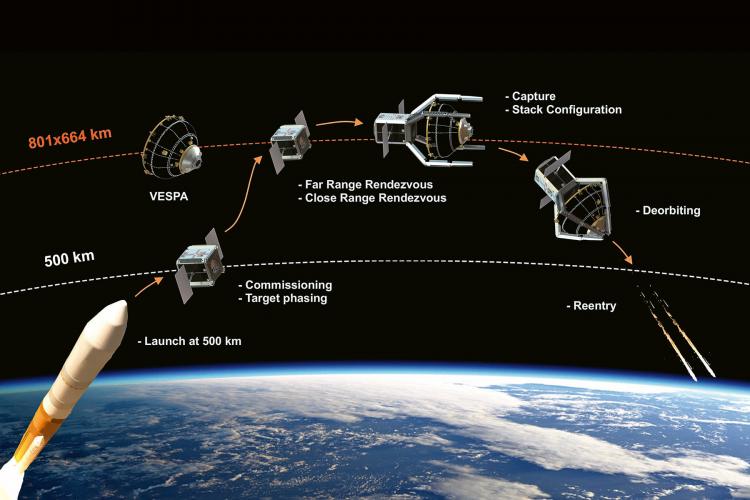Science
Robotics News – Trap the Trash – Robotics Online
Posted 10/16/2020


Our lives are becoming more and more dependent on space technologies. We use satellites for meteorology, communications, navigation, and observation of disaster areas. According to the European Space Agency, ESA, around 40% of modern-day mobile applications rely on satellite and space technology. However, this infrastructure is at risk.
95% of all objects in low-Earth orbit, which is to say at altitudes between 200 and 2000 kilometers, are defective and no longer controllable. They are space debris—such as jettisoned rocket stages, solar panels (including those from satellites), tools, paint chips, and particles of solid fuel. This debris poses a risk to active satellites and to future space missions and their crews. Even the International Space Station has had to maneuver to avoid space debris on several occasions.
Constellations of mini-satellites
The situation is becoming more urgent due to the new satellites that continue to be placed in orbit. Whereas only 50 spacecraft were sent into orbit each year between 2009 and 2012, 800 are scheduled for the current year, and the trend is upward. In the future, most of the new arrivals in space will be nanosatellites, as part of network constellations. For example, the company OneWeb began to build a constellation of around 650 mini-satellites in 2019. Their aim is to enable internet access even in the most remote locations on Earth. Projects like this, as well as the emerging field of space tourism, necessitate the removal of space debris.
With over 34,000 human-made objects currently registered with diameters exceeding ten centimeters, we have reached a critical juncture. If humanity doesn’t do anything about it, an estimated 140,000 objects of junk will accumulate in orbit by 2065. This is because the collision of two objects creates a debris field with a multitude of parts. There is a risk of a dangerous chain reaction.
First debris removal mission by the ESA
Now a Swiss “disposal satellite” is set to do the groundbreaking work of removing a debris object for the first time. Planned for 2025, the ClearSpace One mission, directed by the startup of the same name, will capture the discarded VESPA upper stage (VEga Secondary Payload Adapter) from a rocket launched in 2013 and guide it into the Earth’s atmosphere.
The prototype of this space cleaner will use a “chaser” consisting of four robotic arms to grab and move the disused upper stage at an altitude of 720 kilometers. Twelve maxon drives operate the tentacle-like arms of ClearSpace One. After that, the captured rocket stage will be positioned such that it can be decelerated out of orbit. This procedure will use jet engines on several sides. During a controlled reentry, both the VESPA and the ClearSpace One will burn up in the atmosphere—the biggest “incineration plant” ever.
The idea is that future disposal satellites will repeat this procedure as often as possible. They will also carry away heavier objects in low-Earth orbit to free up space for subsequent space operations.
The researchers at the EPFL Space Center in Switzerland have been working on space debris capture systems since 2010. The engineering knowledge they have gained over the years went into the development of ClearSpace One. In 2017, the project was spun off, resulting in the founding of ClearSpace SA, which began its operations in the maxon lab at the EPFL. As Luc Piguet, CEO and cofounder of ClearSpace SA, observed, “The maxon lab is a hub for technology transfer, making it ideal for startups.” The growing team at ClearSpace has been enhanced by specialist consultants from leading space agencies and companies with mission experience. The advisory board includes luminaries such as Jean-Jacques Dordain, former Director General of the ESA, and Swiss astronaut Claude Nicollier.
It is remarkable for a startup to be given responsibility for a EUR 100 million project. In 2019, ClearSpace prevailed single-handedly against Airbus, Thales Alenia Space (France), and Avio (Italy). Luc Piguet said, “Although we had great confidence in the application we submitted, we were surprised to be allowed to take the lead over a project consortium on our own.” He remained pragmatic, however: “We’ve taken economic considerations into account right from the beginning.” The costs incurred by each de-orbit should be as low as possible. This won over the ESA. Piquet added with a modest smile, “We’re taking on a big responsibility.”
ADRIOS program
The ClearSpace One mission is part of the ESA’s space safety program ADRIOS (Active Debris Removal / In-Orbit Servicing). Its aim is to begin the removal of potentially dangerous space debris. It is hoped that this will pave the way for further missions that will contribute to the responsible development of space. Eight ESA member states, including Switzerland, are providing EUR 86 million for the project. The remaining EUR 14.2 million is coming from sponsors.
A 3D animation of all the pieces of debris orbiting the Earth can be viewed at stuffin.space
Science
Local astronomer urges the public to look up – Windsor News Today – windsornewstoday.ca

If last week’s solar eclipse piqued your interest in astronomy, the Royal Astronomical Society of Canada’s Windsor Chapter plans to show off some of the more dramatic photos and videos members took of the event.
They were stationed along the path of totality along the northern shore of Lake Erie and in the U.S.
“People did take some nice photos with their cellphones, but we have members who took photos and videos with their telescopes,” said member Tom Sobocan. “You’ll see some pretty impressive shots.”
About 100 members are in the local chapter, which meets every third Tuesday of every month.
Thursday’s meeting is at the Ojibway Nature Centre on Matchette Road. It starts at 7:30, and it’s open to the public. Seating is limited, so Sobocan recommends arriving early.
Astronomers are looking ahead to new wonders in the heavens. Right now, the Pons-Brooks Comet, another once-in-a-lifetime opportunity, is approaching Jupiter in the constellation of Aries.
“If you’re in a dark-sky location, you can see it with the naked eye, and from inside the city, you can see it with binoculars,” said Sobocan. “It may get a little bit brighter going towards the fall, but our members have already photographed it with their telescopes.”
It’s a periodic comet which appears in the night sky once every 71 years.
Sobocan said once-in-a-lifetime events, like last week’s eclipse, inspired many of its existing members, but he hopes some new ones will join the group.
“I hope it inspires them to look up at the sky a little bit more often and realize that everything’s in motion in the sky,” he said. “It’s not stationary.”
Science
Giant, 82-foot lizard fish discovered on UK beach could be largest marine reptile ever found – Livescience.com


Scientists have unearthed the remains of a gigantic, 200 million-year-old sea monster that may be the largest marine reptile ever discovered.
The newfound creature is a member of a group called ichthyosaurs, which were among the dominant sea predators during the Mesozoic era (251.9 million to 66 million years ago). The newly described species lived during the end of the Triassic period (251.9 million to 201.4 million years ago).
Ichthyosaurs had already attained massive sizes by the early portion of the Mesozoic, but it was not until the late Triassic that the largest species emerged.
While the Mesozoic is known as the age of the dinosaurs, ichthyosaurs were not themselves dinosaurs. Instead, they evolved from another group of reptiles. Their evolutionary path closely mirrors that of whales, which evolved from terrestrial mammals that later returned to the sea. And like whales, they breathed air and gave birth to live young.
The newly discovered ichthyosaur species was unearthed in pieces between 2020 and 2022 at Blue Anchor, Somerset in the United Kingdom. The first chunk of the fossil was noticed atop a rock on the beach, indicating that a passerby had found it and set it there for others to examine, the researchers explained in the paper. The researchers published their findings April 17 in the journal PLOS One.
The reptile’s remains are made up of a series of 12 fragments from a surangular bone, which is found in the upper portion of the lower jaw. The researchers estimate the bone was 6.5 feet (2 meters) long and that the living animal was about 82 feet (25 m) long.
The researchers named the sea monster Ichthyotitan severnensis, meaning giant lizard fish of the Severn, after the Severn Estuary where it was found. The team believes it is not only a new species but an entirely new genus of ichthyosaur. More than 100 species are already known.
window.sliceComponents = window.sliceComponents || ;
externalsScriptLoaded.then(() => {
window.reliablePageLoad.then(() => {
var componentContainer = document.querySelector(“#slice-container-newsletterForm-articleInbodyContent-5Tm52KifRnJsTxFt8noX8R”);
if (componentContainer)
var data = “layout”:”inbodyContent”,”header”:”Sign up for the Live Science daily newsletter now”,”tagline”:”Get the worldu2019s most fascinating discoveries delivered straight to your inbox.”,”formFooterText”:”By submitting your information you agree to the Terms & Conditions and Privacy Policy and are aged 16 or over.”,”successMessage”:”body”:”Thank you for signing up. You will receive a confirmation email shortly.”,”failureMessage”:”There was a problem. Please refresh the page and try again.”,”method”:”POST”,”inputs”:[“type”:”hidden”,”name”:”NAME”,”type”:”email”,”name”:”MAIL”,”placeholder”:”Your Email Address”,”required”:true,”type”:”hidden”,”name”:”NEWSLETTER_CODE”,”value”:”XLS-D”,”type”:”hidden”,”name”:”LANG”,”value”:”EN”,”type”:”hidden”,”name”:”SOURCE”,”value”:”60″,”type”:”hidden”,”name”:”COUNTRY”,”type”:”checkbox”,”name”:”CONTACT_OTHER_BRANDS”,”label”:”text”:”Contact me with news and offers from other Future brands”,”type”:”checkbox”,”name”:”CONTACT_PARTNERS”,”label”:”text”:”Receive email from us on behalf of our trusted partners or sponsors”,”type”:”submit”,”value”:”Sign me up”,”required”:true],”endpoint”:”https://newsletter-subscribe.futureplc.com/v2/submission/submit”,”analytics”:[“analyticsType”:”widgetViewed”],”ariaLabels”:;
var triggerHydrate = function()
window.sliceComponents.newsletterForm.hydrate(data, componentContainer);
if (window.lazyObserveElement)
window.lazyObserveElement(componentContainer, triggerHydrate);
else
triggerHydrate();
}).catch(err => console.log(‘Hydration Script has failed for newsletterForm-articleInbodyContent-5Tm52KifRnJsTxFt8noX8R Slice’, err));
}).catch(err => console.log(‘Externals script failed to load’, err));
A number of rib fragments and a coprolite, or fossilized feces, were found in the area as well, but they were not definitively attributed to the same animal.
The sediments in which these specimens were found contained rocks that indicated earthquakes and tsunamis occurred during that time, which suggests that this species lived during a time of intense volcanic activity that may have led to a massive extinction event at the end of the Triassic according to the researchers.
A similar specimen was discovered in Lilstock, Somerset in 2016 and described in 2018. Both were found in what is known at the Westbury Mudstone Formation, within 6 miles (10 kilometers) of each other. This ichthyosaur was estimated to have been as much as 85 feet (26 m) long, although the authors of the latest study believe it was slightly smaller.
The previous contender for the largest marine reptile was another ichthyosaur, Shonisaurus sikanniensis, which was up to 69 feet (21 m) long. S. sikanniensis appeared 13 million years earlier than I. severnensis and was found in British Columbia, making it unlikely that the new discovery represents another specimen of the previously known species.
A similarly massive ichthyosaur called Himalayasaurus tibetensis, which may have reached lengths of 49 feet (15 m), was discovered in Tibet and described in 1972. It dates to the same period, meaning that it probably is not the same species as the new discovery either.
I. severnensis was likely among the last of the giant ichthyosaurs, the researchers claim. Ichthyosaurs persisted into the Cenomanian Age (100.5 million to 93.9 million years ago) of the late Cretaceous period (100.5 million to 66 million years ago). They were eventually supplanted by plesiosaurs — long-necked marine reptiles that went extinct at the end of the Cretaceous, alongside all non-avian dinosaurs.
Science
Federal government announces creation of National Space Council | RCI – Radio-Canada.ca


- Home
- Politics
- Federal Politics
The Canadian Space Agency also received a proposed $8.6 million for its lunar program
Nicole Mortillaro (new window) · CBC News
Canada’s space sector received a boost from the federal government in its budget, both in terms of money and vision.
The 2024 budget (new window) included a proposal for $8.6 million in 2024-25 to the Canadian Space Agency (CSA) for the Lunar Exploration Accelerator Program (new window) (LEAP), which invests in technologies for humanity’s return to the moon and beyond.
In addition to the funding, the federal government also announced the creation of a National Space Council, which will be a new whole-of-government approach to space exploration, technology development, and research.
For Space Canada (new window), an organization comprised of roughly 80 space sector companies including some of Canada’s largest, such as Magellan Aerospace (new window), Maritime Launch (new window) and MDA Space (new window), it was a welcome announcement.
We’ve been advocating for it since the inception of our organization, and we were really very happy, and we applaud the federal government’s commitment announced in the budget,
said Brian Gallant, CEO of Space Canada.
Gallant said that investment in space is an investment in Canada.
Two-thirds of space sector jobs are STEM jobs. These are good paying solid jobs for Canadians. And on top of that, we have approximately $2.8 billion that is injected into the Canadian economy because of the space sector,
he said.
The U.S. formed its National Space Council in 1989, but it was disbanded in 1992 and reestablished in 2017.
In the 2023 budget (new window), the government announced proposed spending of $1.2 billion over 13 years, that was to begin in 2024-25, to the CSA’s contribution of a lunar utility (new window) vehicle that would assist astronauts on the moon. The as–yet–developed vehicle could help astronauts move cargo from landing sites to habitats, perform science investigations or support them during spacewalks on the surface of the moon.
It also proposed to invest $150 million over five years for the LEAP program.
MDA Space, the company behind Canadarm, was also pleased with the announcement.
Canada has an enviable global competitive advantage in space and the creation of a National Space Council is critical to Canada maintaining that leadership position,
CEO Mike Greenley said in an email to CBC News.
Space is now a rapidly growing, highly strategic and competitive domain, and there is a real and urgent need to recognize its importance to the lives of Canadians and to our economy and national security.
The next project for MDA is Canadarm3, which will be part of Lunar Gateway, a international space station that will orbit the moon. It will serve as a sort of jumping-off point for astronauts heading to the moon and eventually beyond.
The Lunar Gateway is a great opportunity for Canada and for MDA Space to not only provide the next generation of Canadarm robotics but to clearly plant our flag as a core national and industry participant in the Artemis era,
Greenley said.
Lunar Gateway is set to begin construction no earlier than 2025 (new window), according to NASA.
-



 Tech20 hours ago
Tech20 hours agoiPhone 15 Pro Desperado Mafia model launched at over ₹6.5 lakh- All details about this luxury iPhone from Caviar – HT Tech
-



 Sports20 hours ago
Sports20 hours agoLululemon unveils Canada's official Olympic kit for the Paris games – National Post
-



 Science23 hours ago
Science23 hours agoAstronomers discover Milky Way's heaviest known black hole – Xinhua
-
Media22 hours ago
NPR's liberal bias: Editor exposes media's lack of viewpoint diversity – USA TODAY
-
News18 hours ago
Toronto airport gold heist: Police announce nine arrests – CP24
-



 Tech18 hours ago
Tech18 hours agoVenerable Video App Plex Emerges As FAST Favorite – Forbes
-
Investment14 hours ago
Saudi Arabia Highlights Investment Initiatives in Tourism at International Hospitality Investment Forum
-
News15 hours ago
Loblaws Canada groceries: Shoppers slam store for green onions with roots chopped off — 'I wouldn't buy those' – Yahoo News Canada









